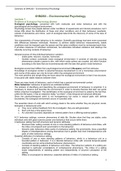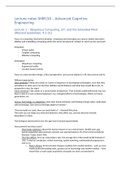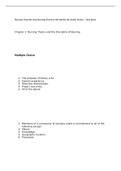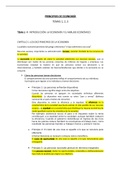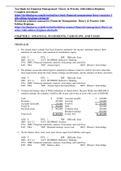Summary of 0HM260 – Environmental Psychology
0HM260 – Environmental Psychology
Lecture 1
Problems of Ecological Psychology (Barker)
Ecological psychology: concerned with both molecular and molar behaviour and with the
psychological and ecological environment.
Psychology knows how people behave under conditions of experiments and clinical procedures, but it
knows little about the distribution of these and other conditions and of their behaviour resultants,
outside of laboratories and clinics. Lack of ecological data limits the discovery of some of the laws of
behaviour.
One characteristic of human behaviour is its variation. Scientific psychology has been more concerned
with differences between individuals. However, to achieve stable behaviour measurements, stable
conditions must be imposed upon the person and the same conditions must be re-imposed each time.
It provides measures of individual constancies, but eliminates individual variations and destroys the
naturally occurring contexts of behaviour.
General sources of intra-individual behaviour variation:
- Inside parts; neurons, muscles, hormones
- Outside context: constitutes molar ecological environment. It consists of naturally occurring
phenomena outside a person’s skin, with which molar actions are coupled, but which function
according to the laws that are incommensurate with the laws that govern molar behaviour.
Ecological environment differs from psychological environment (life-space) and from stimulus.
Knowledge of ecological context is essential because development is not a momentary phenomenon
and course of life-space can only be known within the ecological environment.
The most primitive and simple thing we know about the ecological environment is that it has structure;
it has parts with stable relations between them.
There are many levels of behaviour, each of which has a special environmental context.
Molar behaviour: behaviour of persons as undivided entities;
The problem of identifying and describing the ecological environment of behaviour is empirical. It is
necessary to observe and describe the environment in order to develop theories that later can guide
further empirical investigation. The identification of the ecological environment is aided by the fact that,
unlike the life-space, it has an objective reality "out there"; it has temporal and physical attributes.
Since the physical-temporal world is not homogeneous but exists in natural parts with definite
boundaries, the ecological environment occurs in bounded units.
The essential nature of units with which ecology deals is the same whether they are physical, social,
biological or behavioural units:
a. They occur without feedback from the investigator, they are self-generated;
b. Each unit has a time space locus;
c. An unbroken boundary separates an internal pattern from a differing external pattern.
K-21 behaviour settings: common phenomena of daily life. Studies show that they are stable, extra
individual units with great coercive power over behaviour that occurs within them.
A behaviour setting has both structural and dynamic attributes.
- Structural side: setting consists of one or more standing patterns of behaviour-and-milieu, with
the milieu circumjacent and synomorphic to the behaviour.
- Dynamic side: behaviour-milieu parts of a behaviour setting, the synomorphs, have a specified
degree of interdependence among themselves that is greater than their interdependence with
parts of other behaviour settings.
Essential attributes of a behaviour setting;
- Consists of one or more standing patterns of behaviour, which is a behaviour unit or a
bounded pattern in behaviour. It is a discrete behaviour entity with univocal temporal-spatial
coordinates and an extra-individual behaviour phenomenon.
- Consists of standing patterns of behaviour and milieu. The behaviour patterns of a setting are
attached to particular constellations of nonbehavioral phenomena. The milieu of a setting
exists independently of standing pattern and independently of anyone’s perception of the
setting.
- Milieu is circumjacent to behaviour: essential attribute of milieu of a behaviour setting.
1
,Summary of 0HM260 – Environmental Psychology
- Milieu is synomorphic (similar in structure) to behaviour: it describes an essential feature of
relationship between behaviour and milieu of a behaviour setting.
- Behaviour-milieu parts are synomorphs.
- Synomorphs have a specified degree of interdependence.
- Synomorphs have a greater degree of interdependence among themselves than with parts of
other behaviour settings.
Geographical locus: precise position in space which can be designated with degree of precision the
investigation requires.
Temporal locus, serial occurrence, and duration: behaviour settings may occur only once, on a
specified day, or they may recur according to some temporal schedule of days.
Population: behaviour setting has a definite number of inhabitants at each occurrence. This
population can be identified with respect to whatever attributes are relevant.
Occupancy time: number of person-hours a setting is occupied over a designated period of time;
product of mean population per occurrence and duration in hours of all occurrences.
Functional position of inhabitants: settings have an internal structure, and individuals and
categories of individuals occupy the various parts to different degrees. An important feature of internal
structure of a is power that different parts exercise over its functioning. This power can be determined
with some precision; it ranges from parts with virtually no power over the setting to the part with control
over the entire behaviour setting (penetration dimension). Performance zones are parts of a setting
with some direct power over all or a part of its functioning; persons who inhabit performance zones are
performers.
Action patterns: pattern of behaviour of a setting has limitless attributes.
Behaviour mechanism: pattern involves different effector systems to various degrees.
Pressure: behaviour settings differ in degree to which they bring pressure upon different population
subgroups to enter and participate in them.
Autonomy: behaviour settings differ in the extent to which their functioning is influenced by
occurrences originating within and outside the community.
Welfare: settings differ in degree to which they cater to needs of population subgroups.
8 possible sources of synomorphy of standing behaviour patterns and no psychological milieu:
1. Physical forces: physical arrangements can enforce some patterns and prevent others.
2. Social forces: can be strongly coercive.
3. Physiological processes
4. Physiognomic perception
5. Learning: learning of behaviour suitable for particular behaviour-milieu synomorphs is an
important source of the conformity of individuals to the standing patterns of behaviour.
6. Selection by persons; affinity between the standing pattern of a behaviour setting and the
behaviour repertoires of the persons who enter it.
7. Selection by behaviour settings: some behaviour settings have entrance requirements that
exclude persons whose behaviour does not readily conform to that of the standing pattern and
to the requirements of the milieu.
8. Influence of behaviour on the milieu
2
,Summary of 0HM260 – Environmental Psychology
Environmental Psychology: Behaviour and Experience in Context (Cassidy)
1. Environmental Psychology: What is and why you should know about it
Environmental psychology:
- Burroughs: study of interrelationships between physical environment and human behaviour.
- Gifford: study of transactions between individuals and their physical settings.
The process is reciprocal between person and environment.
Lewin’s equation/person-in-context approach; b=f(p,e).
B = behaviour p = person e = environment
States that behaviour is a function of person, environment and interaction between the two.
Basic principles of environmental psychology:
1. Interactional perspective: behaviour is a function of person, environment and interaction
between the two.
2. Applied research focus in which there is an integration of theory and practice
3. Multiple levels of analysis from individual to societal/organizational, all are used with a
particular emphasis on the molar level
4. Research base in field or natural environment
5. Multimethod approach
6. Model of person as active rather than passive in interacting with environment.
7. Interdisciplinary perspective
8. Holistic rather than reductionist approach.
9. Systems model of relationship between aspects of environment and behaviour.
Lewin’s major concerns:
- Interdependence of theory and application
- Research should be based on real world situations in terms of action research and field
theory.
- Interactional model for explanation of behaviour and experience b = f(p,e)
Areas of focus:
- Person-in-context: behaviour and experience best understood within interactional framework.
- Interdependence of theory and practice: theory should be driven by social problems.
- Research located in real world: field theory provides model for conceptualizing research
problems which incorporated person and situation variables in an ecological model of
behaviour. His action research approach is an approach based on the assumption that the
best way to understand behaviour was to try to change it.
Ideas provide working model for applied research which is macro level and non-reductionist, problem
focused, utilized current theory and aimed to score high in ecological validity.
Environmental perception: how we actually perceive the context in which we live with its rich
interplay of social and physical elements.
Study of perception in cognitive psychology attempts to explain how we become aware of information
in our environment, process that information and give meaning to that information. Initially theories
tended to be one of two types:
1. Bottom-up theories: how information and finally environment determines interpretation.
2. Top-down theories: how previous experiences influence interpretation of new information.
Now it is generally accepted that any universal theory of perception should include both.
As we grow and develop, we encounter a wide range of information which increases in complexity the
complexity of encountered environments. We develop cognitive schemata (maps of our world) which
guide our perceptual processes. Essential aspects of this guidance are filtering of and giving meaning
to incoming information from environment. Filtering occurs at all stages and determines what aspects
we attend to, what we store in memory and ultimately to which we respond.
Brunswick’s lens model: based on the probabilistic nature of the perceptual process. Environmental
cues contain information which is more or less accurate in terms of representations of external world.
Perceptual processes sample these environmental cues and make probabilistic judgments about them
which lead to perceptual representation.
Gibson’s ecological theory: bottom up, with a focus on fundamental properties of external world in
generating a perceptual repertoire. All stimuli in the environment contain information and pose the
3
, Summary of 0HM260 – Environmental Psychology
central problem of perception research as determining how stimuli provide this information, what he
called the laws of stimulus information. Affordances of the environment are what it offers the animal,
what it provides or furnishes, either for good or evil. Different environments offer different things to
species.
Neisser distinguishes between two aspects of perception:
- Seeing a process: fairly passive and driven by information contained in environmental stimuli.
- Thinking: top-down or constructivist aspects.
He proposes a perceptual cycle which involves attention, motivation and perceptual processes in
dynamic process being stimulated by and acting upon information from all sense modalities.
Gregory suggested that the perceptual process is analogous to scientific process of generating and
testing hypothesis. Individual’s previous experience, stored in memory, is all important in the process.
Theory is top-down. Perception involves higher level cognitive elements involved in thinking.
Theory of personal constructs (Kelly): central is constructive alternativism which is embodied in the
proposition that there are as many different forms of reality as individual is capable of construing.
Transactional approach considers person and environment as interdependent parts of one
transactional process. To focus of study is switched from analysis of subject or object to a focus on the
process of interaction between the two. The outcome of the transaction between person and
environment is the production of a phenomic environment which is ultimately unique to the individual.
Carpenter world hypothesis (Turnbull): how different environmental experiences can lead to
differences in perception between cultures.
The environment provides information (affordances) which are necessary and important in the
perceptual process. The environment shapes our perceptual processes by determining the content of
our perceptual memory, in the developmental process. The person selects, interprets and gives
meaning to information received and constructs a phenomic environment which then overrides the
objective environment in determining behaviour.
Environmental appreciation: emotional or evaluative element in terms of how we feel about our
environment.
Kaplan and Kaplan have linked environmental cognition with environmental evaluation. Four aspects
of environments which are important in relation to our emotional response are:
- Coherence: organization of arts and how well the whole fits together.
- Legibility: how easily the observer can read the environment.
- Complexity: attracts attention and hold our interest together with mystery.
- Mystery
Another important aspect is novelty of the environment. Happy medium rule: optimum level of
environment elements exist which produces satisfaction and appreciation in the person.
Environmental personality: based on notion that there may exist stable traits reflected in our
differential responses to different environments.
Murray’s needs-press theory of personality explained behaviour in terms of interaction between
needs of the person and influence of environment, the press.
2. Theory and method in environmental psychology
Veitch and Arkkelin identify four major historical trends:
1. Geographical determinism: geographical environment directly influences behaviour and
experience in that it provides challenge. Extremely low levels of challenge fail to provide
necessary stimulation, extremely high levels are damaging. An intermediate level of challenge
leads to development of appropriate coping responses and particular types of behaviour and
experience which enhance survival within specific environment.
2. Ecological biology: initial human response to external factors as instinctual, child being born
with a set of instinctual responses, help it to survive.
3. Behaviourism: two very important contributions:
a. Interactionism: person-situation.
b. Analysis of ways in which physical environments enhance/constrain behaviour.
4

